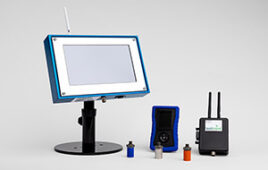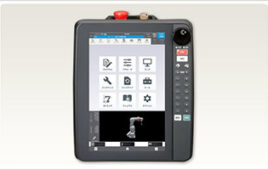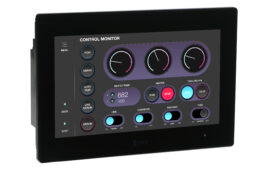By Ed Nugent, COO, PcVue Inc.
Stationary Human Machine Interface (HMI) displays are being replaced by contextual HMI. Whether a single line display or a dedicated touch screen, stationary HMI are failing to meet mobile operators’ expectations. Today’s workers want information at their fingertips and they increasingly look to their mobile device to provide it.
The same is true for maintenance workers. Time is wasted when a maintenance engineer has to repeatedly move back and forth between a stationary HMI and the physical location where maintenance is performed. In many cases, the location where the work is to be done is actually on the opposite side of the equipment from the stationary operator HMI. This is the case during commissioning, troubleshooting repairs and during equipment changeover and startup.

Contextual HMI can provide a simple and elegant solution. On a mobile device it eliminates navigating a screen designed for a workstation on a much smaller screen, as is the case when using a web browser to display a workstation HMI.
Contextual, in the case of HMI, means in the context of the worker’s location and work to be performed. If the contextual mobility server is aware of the location of the mobile device and has validated the user, it is able to push specific HMI components to the worker’s mobile device. For security and safety reasons, the HMI must be automatically removed from the device when the worker moves away from physical proximity to the equipment being worked on.
To realize the benefit of contextual HMI, it is a matter of deploying a straightforward infrastructure. A contextual mobility infrastructure is centered on the smart mobile device. It takes advantage of standard indoor and outdoor geo-location technologies found on nearly all modern mobile devices to provide a dynamic and contextual HMI based on the worker’s proximity to a predefined geographical zone. A zone may be an entire facility, a room, or it may also be in the direct proximity of a specific piece of equipment.

Geo-tags such as Bluetooth Low Energy Beacons (iBeacons), Near Field Communications (NFC), and QR Codes are placed strategically in these geographic zones of control, known as geo-zones. A secure proximity services mobile app on the device receives the ID of the geo-tags in range of the device. If more than one is in range (i.e. two Bluetooth beacons are detected), the one with the stronger signal is used. This concept, known as geo-fencing, allows actions based on zones of control. The mobile app communicates with the contextual mobility server using a standard Internet Protocol (IP) connection such as Wi-Fi or cellular network. The contextual mobility server is responsible for evaluating and responding with the necessary information and controls pushed to the user’s mobile device automatically. The required information and control is evaluated based on the current geo-zone and as determined by the mobile worker’s login profile.
There can only be one supervisor of equipment so neither the mobile app nor the contextual mobility server communicates directly to the equipment. The supervisory system retains responsibility for communication with equipment or other assets that it supervises. The contextual mobility server must reflect the real-time status of the equipment variables or tags by using OPC or other real-time methods to synchronize with the supervisory equipment.
The cornerstone of the infrastructure is the contextual mobility server and its Contextual Logic Engine (CLE). The contextual mobility server maintains a database that associates geo-zones and user profiles with information, equipment controls, actions and events. The CLE determines the appropriate actions and triggers the distribution of information and control elements to the mobile worker. This includes additional resources (drawings, schematics, etc.) needed by the worker in the performance of their job.
Both operations and maintenance personnel now have the relevant HMI they need for situation awareness and intelligent control in their area of work responsibility. It is literally at their fingertips as it is pushed to their device automatically when the app and contextual mobility server detect that the device has entered a geo-zone. This eliminates requiring navigation designed for a computer monitor, when using the smaller mobile device screen. It provides improved performance and operational efficiency while also increasing safety.
The connected supervisory system is enhanced when augmented with contextual HMI capability. Knowing the location and routes of mobile workers provides the ability for control room assistance with efficiency, safety, and security issues. For example, the control room is now able to see where workers are or have been in order to recognize unauthorized access to restricted areas. They can dispatch the nearest certified technician in the case of a maintenance emergency and assist with safe passage routes in the need for evacuation.
A private and secure internal messaging system is also an essential element of a contextual mobility infrastructure. It allows mobile workers to exchange information with each other and with the control room. This includes text, photos, videos and audio recordings.
Integrated messaging is preferable to alternatives, such as SMS (short message service), due to the fact the messages become a permanent part of the Operations & Maintenance (O&M) record. A messaging system is particularly useful as an electronic notebook for shift handoff since messages can be directed to a group as well as individuals.
Deployment of a contextual mobility infrastructure includes ensuring that there is access to the network for the mobile device in all work locations. Design of the geo-zones and placement of the geo-tags is the next step. Finally, the configuration of a contextual mobility server is a matter of defining the content to be sent in each geo-zone and user profile.
While there is a cost associated with the deployment of a contextual mobility infrastructure, it is more than offset by the elimination of many, if not all, of the stationary HMIs and the increased efficiency of the O&M team. When you factor in the impact of improved safety and security, it is obvious why the trend is away from stationary HMI and toward contextual HMI.
PcVue Inc.
www.pcvuesolutions.com
Filed Under: Displays • HMIs • operator interfaces • monitors




